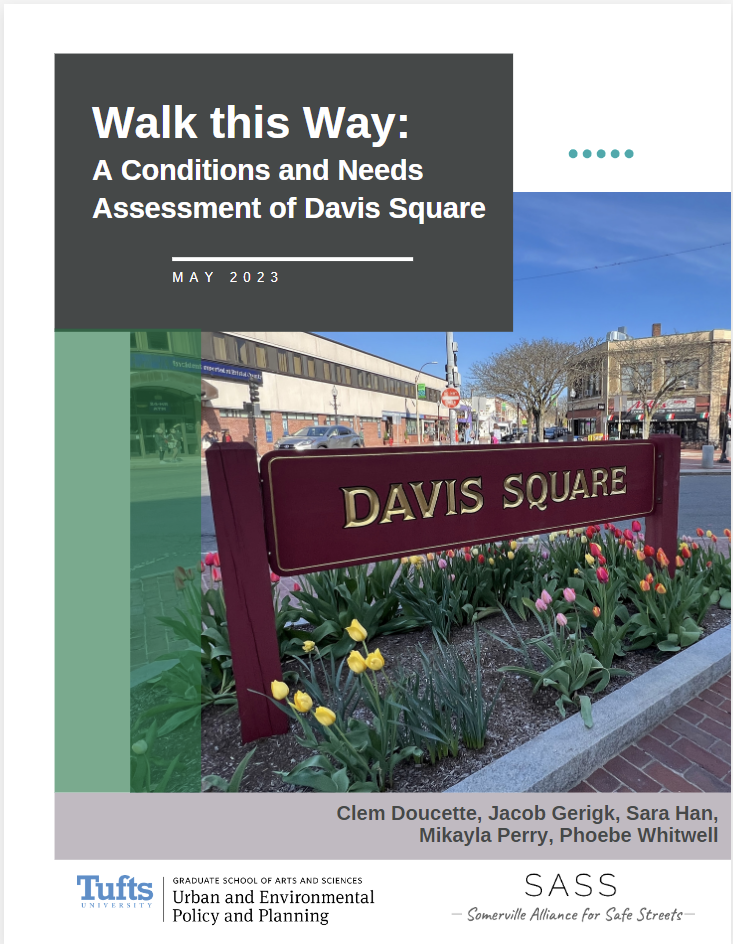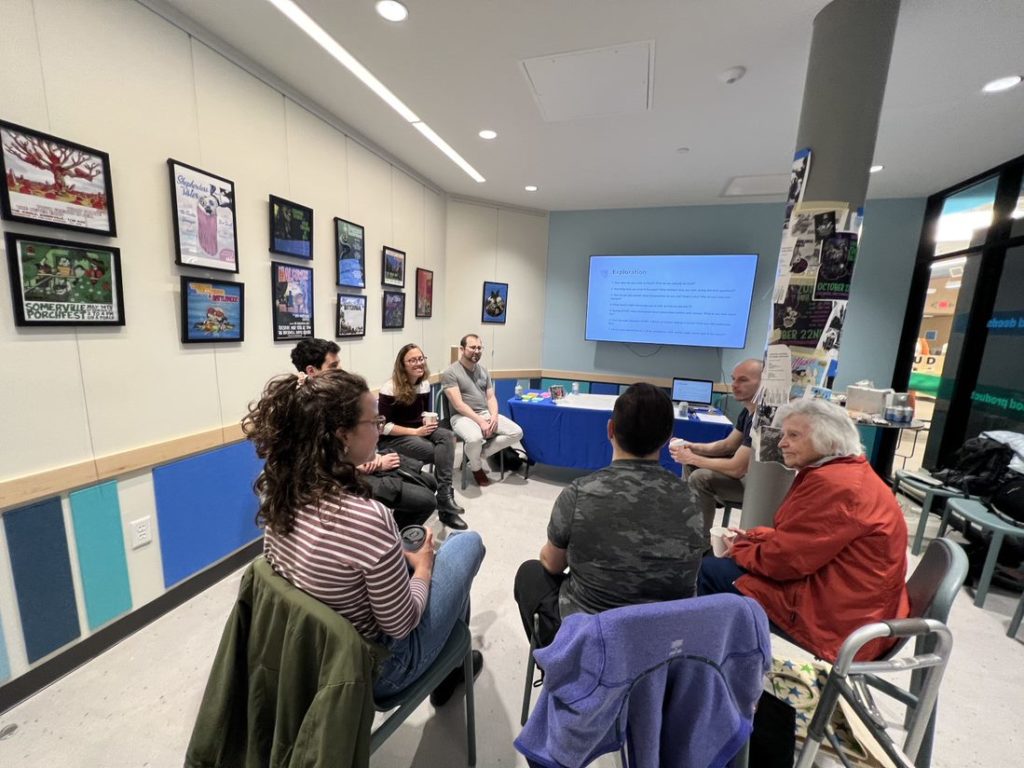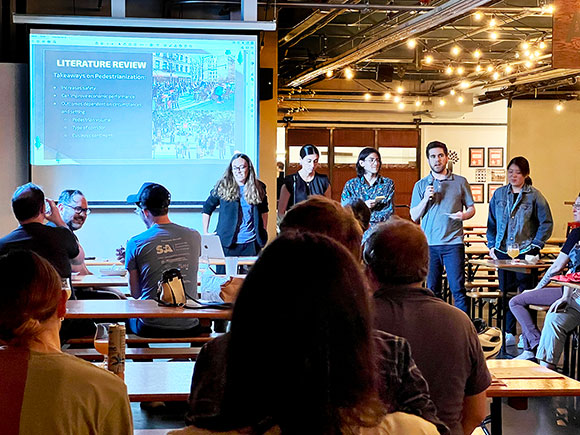All of the Field Projects from last Spring concluded with outstanding presentations, but only one team took their production “on tour.” The Davis Square team continued to present their research and findings at community stakeholder events this summer, even after the semester-long course ended. In this blog post, the Davis Square team shares their Field Project experience, including designing a research methodology, collaborating with a local organization, tackling real-world issues, and the value of learning how to work together as a team.
By Clem Doucette, Sara Han, Jacob Gerigk, Mikayla Perry, and Phoebe Whitwell
Project Scope

Our Field Projects team included five first-year UEP students, Clem Doucette, Sara Han, Jacob Gerigk, Mikayla Perry, and Phoebe Whitwell. We were privileged to be partnered with Somerville Alliance for Safe Streets (SASS), with our specific project partner being Stephanie Galaitsi. Stephanie is a Tufts Alum, having received her Master of Science in Environmental Engineering in 2013. The project proposal that SASS presented us with was to examine the existing streetscape use patterns on Elm Street to provide actionable information for the city of Somerville to incorporate into any designs or plans to pedestrianize Davis Square. SASS originally proposed this project because it aligned with its mission of providing equitable access to all public domains in Somerville. Within this project, we were to present deliverables that SASS outlined as follows:
- The History of Streetscapes in Davis Square
- Current Conditions in Davis Square
- Streetscape Use
- Proposal for Streetscape Design for Davis Square
- Interviews
Since this project was only due to last a semester’s length, our group shortened some of the original expectations presented, including an economic analysis. Our Davis Square Streetscape Study began as a project that had great room for growth, and upon completing our final presentation, it has continued to be put to use. This project is invaluable as it gave us master’s candidates room to gain real-world experience in a small-scale city setting, and our team ultimately was able to decide our course of action.
Working as a Team

As we began to develop a working relationship for the semester, we found it important to identify what each of our strengths and preferences were and how they could benefit our team. The best part about working in a team is that each member can play to their strengths, which helps make up for any weaknesses one person may have. During our “White House” meetings, we outlined tasks on a chalkboard and stayed organized by using Asana, a project management tool. We also discussed and picked our different roles on each task (e.g. interviewer, GIS mapper, focus group lead, Zoom technical lead). While having a role can create a sense of ownership for the group and the project, we remained flexible in case of changes and assumed shared responsibility to get the work done. Occasionally, at the end of our meetings, we would whip out the online game GeoGuessr to play for a quick break. Over the course of the class, we built teamwork and trust, and are proud to have crafted a meaningful report and presentation for SASS.
Evolution of the Project
The joke the teaching team had for our project was that we were doing “all of the methods.” This was something that evolved over the course of the Field Projects experience. When we first discussed our scope with Stephanie, there were many possible pieces we could have included, such as digging through the archives of the Somerville Museum, coming up with a proposal for a streetscape design, or doing a feasibility study. We decided to focus on fieldwork and community outreach, asking people their opinions of Davis Square and what they saw as the most pressing needs for the area. Our goal was that by painting an accurate picture of the current status of the Square, we would be able to draw conclusions about the potential impacts of pedestrianization.
The Field Projects class gave us an opportunity to not only apply our planning and research skills to a local community context, but also taught us valued skills that make group work, work. We first learned this through the tower-building exercise. On the first day of class, we were asked to get into our Field Projects group and build a tower as tall as possible using a mix of materials: paper, folders, tape, pencils, markers, and paper bags. We were excited to meet and tackle our first task together as a team using the limited resources we had. Upon reflection, this activity showed us how much an agreed strategy saves time and how to deal with curve balls. All of us worked towards the same goal of building a tall and supportive tower, but we each had different ideas on how to achieve it (rolling paper into columns or using folders as vertical support). Although we were able to adjust to a method that worked, we also came across unexpected challenges that pushed us to think on our feet. This partly involved carefully moving our tower from the second floor to the first floor of Sophia Gordon Hall since it started to reach the ceiling! Simply put, we never gave up on our tower and remembered to have fun in the process.
Even though we had narrowed our scope, we soon discovered that what we had decided to do was still plenty of work to fill the semester. We spent the month of February standing out in Davis Square, counting every car, pedestrian, and cyclist that passed by (it was cold!). We also completed our literature review, looking at the general positive and negative impacts of pedestrianization as well as case examples from similar areas. In March, as soon as we got approval from the Internal Review Board, we launched our survey to the public and began conducting interviews with activists and business owners. This allowed us to both summarize aggregate feedback from a wide range of community members and to go deeper with people who had specific perspectives we were interested in. We rounded out our work with another quantitative method by doing some GIS mapping with crash data available through MassDOT.

We had intended to conduct some interviews with general community members as well and had provided an option on our survey for people to express interest in speaking with us. We ended up getting so much interest that it became clear we would never be able to complete interviews with everyone! We therefore pivoted to conducting five community focus groups on Zoom and in person, adding another method to our project — you can see why the teaching team came up with their joke. Ultimately, even though all of these methods were at times overwhelming, we found that exploring multiple avenues made our project stronger. As we sat down to write out our conclusions and recommendations, we were struck by the many areas of alignment in our findings between different methods; for instance, areas that showed as crash hotspots in our GIS analysis that were also identified as “unsafe” or “inconvenient” places by focus group participants.
Community Participation
After distributing our survey online and via publicly posted flyers throughout Somerville and Cambridge, we received a total of 687 survey responses – a number that vastly exceeded our initial expectations. We distributed our flyers in five commonly-spoken languages in Somerville (English, Spanish, Portuguese, Haitian Creole, and Cape Verdean Creole) to reach and engage with as large of a community as possible. After closing the survey at the end of March, we tagged all the responses with common themes to quantify and assess public input.
The participation and passion that the community of Somerville showed throughout the course of our project was amazing, and we would like to thank everyone who volunteered their time and resources to sit for an interview, join a focus group, or fill out and share our survey. The input we received from the community was invaluable to the success of our project and our understanding of the needs and conditions of Davis Square.
Summary of Findings
Following a long process of synthesizing the findings of our various research methods, we were able to identify a few common themes across our research:
- The majority of surveyed community members see pedestrian safety and accessibility in Davis Square as a priority.
- Elm Street and the square’s central intersection are hot spots of congestion and vehicular incidents, with many community members considering these corridors as inconvenient and unsafe for pedestrians.
- While surveyed community members had divided opinions on closing Elm Street to cars, our literature review finds that pedestrianization can be beneficial if gradually implemented with good communication and community buy-in.
While it is difficult to encapsulate every community member’s opinions and wishes in our final report, we made the following policy recommendations based on the results of our research:
- Increase pedestrian accessibility by improving physical infrastructure in Davis Square.
- Foster safe and efficient traffic flow for all users of the Square by reprogramming traffic and crossing signals, increasing the number of loading spaces, and constructing bike lanes.
- Develop a pilot program for temporary weekend closures of Elm Street to vehicular traffic.
Beyond Field Projects Class

We hope the results of our project will help inform and shape plans for Davis Square moving forward. Human-scale developments and improvements that prioritize safety and accessibility can reclaim spaces currently unavailable to businesses, pedestrians, and cyclists. As such, our recommendations aim to create an environment that can be safely accessed by all users of the square.
Even as the semester came to an end, we continued to engage with the community about our research. We presented our findings at Aeronaut Brewery at Streetwise, a monthly speaker series put on by the Somerville Alliance for Safe Streets and the Somerville Bicycle Committee. The opportunity to engage with passionate community members during the presentation and ensuing Q&A added fresh perspectives and insights to our research. Presenting our findings to the community that shaped our project through surveys, interviews, and focus groups felt like a fitting end to our project.